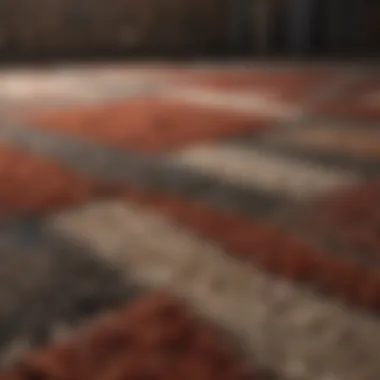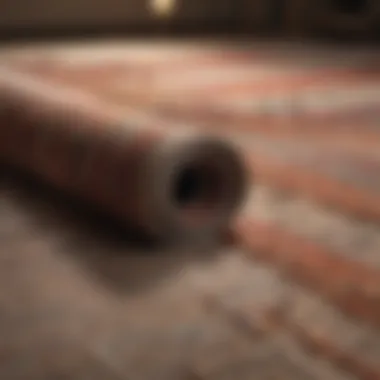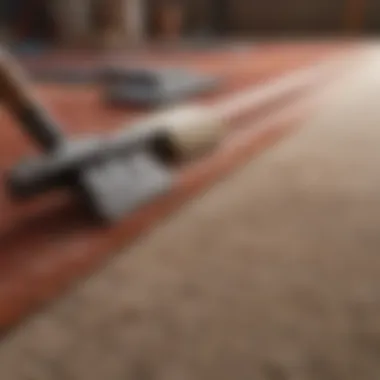Cost Considerations for Carpet Installation


Intro
When considering new flooring options, homeowners often overlook the subtleties of carpet installation costs. Understanding these costs is essential for making informed choices that align with both aesthetic preferences and budgets. In this article, we explore the various factors impacting carpet installation prices, from materials to labor and additional fees. Homeowners and design enthusiasts will find valuable insights here to help navigate the complexities of budgeting for their carpet projects.
Design Inspiration
Trending Styles
Carpet styles have evolved over the years, reflecting shifts in design philosophies and consumer preferences. Currently, popular options range from plush, luxurious textures to low-pile carpets that offer a minimalist aesthetic. Berber carpets are favored for their durability. These carpets work well in high-traffic areas due to their resilience. Another trend is the use of patterned carpets, which add visual interest to any space. When selecting a style, consider the overall theme of your home or the specific room where the carpet will be installed.
Color Palettes
Color selection plays a significant role in influencing the mood of a room. Subtle hues like soft grays and earthy tones can create a calming environment, while vibrant colors can energize a space. Mismatching carpet color with wall paint or furnishings can detract from your design vision. It is advisable to choose colors that harmonize well with existing decor. Samples should be obtained to assess how colors look under different lighting conditions.
Cost Factors
Material Costs
The choice of carpet materials directly affects overall installation expenses. Synthetic fibers, such as nylon and polyester, are often less expensive than natural fibers like wool. Understanding the properties of different materials helps in selecting the right carpet. For example, nylon is known for its durability, while wool provides a luxurious feel. Performance characteristics, such as stain resistance, also vary between materials.
Labor Considerations
Labor costs can vary widely based on the installer’s experience and the complexity of the project. Installation may require additional preparation, such as removing old flooring or repairing subfloors, which can significantly increase labor expenses. Bidding multiple contractors and comparing quotes can uncover substantial differences.
Additional Fees
Be aware of potential additional fees associated with carpet installation. These can include costs for moving furniture, disposal of old carpet, and any special treatments for the carpet. Thoroughly reading the contract is crucial. Always clarify which services are included in the pricing.
Practical Tips
Maintenance & Care
Proper maintenance is vital to extending the life of your carpet. Regular vacuuming and immediate attention to spills can prevent staining and wear. Professional cleaning is often recommended every 12 to 18 months to maintain appearance and hygiene. Consider using carpet protectors or treatments for added longevity.
Budgeting & Planning
Effective budgeting for carpet installation involves accounting for all associated costs. Include material, labor, and potential additional fees in your budget. Having a cushion for unexpected expenses is advisable. Creating a detailed plan will help manage your finances effectively.
Important Note: Always obtain multiple estimates before proceeding with any installation.
Prelims to Carpet Installation Costs
Understanding the financial implications of carpet installation is crucial for homeowners and design enthusiasts. This knowledge not only informs decisions but also aligns projects with budget capacities. Carpet installation is more than just laying down beautiful flooring; it encapsulates a range of costs that can vary based on multiple factors. Insight into these costs helps to manage expectations and avoid unexpected financial burdens.
Homeowners and design enthusiasts should initiate their journey by considering several critical elements. Recognizing the types of materials available aids in making informed choices, impacting both the aesthetic and the budget. Furthermore, understanding labor considerations is vital, as these can greatly influence the overall cost based on the complexity of the job and regional differences.
In addition to primary expenses involved in carpet installation, it is important to contemplate secondary costs that may arise, such as disposal and maintenance. Thus, a comprehensive view on carpet installation costs not only prepares one for the evident financial requirements but also addresses potential hidden expenses. Ultimately, grasping these nuances leads to more successful and satisfying flooring choices, aligning design aspirations with financial realities.
Overview of Typical Expenses
When discussing carpet installation, it is essential to delineate the typical expenses that homeowners might encounter. These expenses encompass a wide spectrum, including the cost of the carpet itself and the labor needed for installation.
- Material Costs
The price of carpet materials varies significantly based on the type of fibers used. Options range from inexpensive polyester to premium wool. Generally, higher-quality materials not only enhance durability but also provide a more sophisticated appearance. - Labor Costs
Labor is often one of the highest expenditures in carpet installation projects. Rates can fluctuate based on geographical location, installer experience, and job complexity. An experienced professional may cost more initially but can often lead to better installation and longevity. - Additional Supplies
Carpeting projects may require extra supplies, such as padding, adhesives, or tools. These can add up, so it's advisable to account for them in the overall budget. - Miscellaneous Costs
Homeowners may also face fees for removing old carpet, disposing of debris, or preparing the installation site. These costs, while seemingly minor, can accumulate and impact the budget significantly.
Understanding these typical expenses lays the groundwork for homeowners to create a realistic budget, ensuring that their carpet installation journey is both fulfilling and financially sound.
Factors Affecting Carpet Installation Pricing
Understanding the factors that influence carpet installation pricing is essential for homeowners looking to make informed decisions. Several variables directly impact the overall costs, including the quality of materials, labor expenses, and the specifics related to the room where the installation takes place. Knowing these factors can help you manage your budget effectively and provide insight into how to navigate the choices involved in the installation.
Material Quality


Types of Carpeting
When considering the types of carpeting, it is crucial to recognize the variety available in the market. Each type serves different purposes and comes at varying price points. Common types include nylon, polyester, wool, and berber. Each type has unique characteristics that make it suitable for specific environments. For instance, nylon is known for its durability and is often used in high-traffic areas. Wool, on the other hand, offers a luxurious feel but may require a higher investment.
The key characteristic of carpeting types is how they align with the needs of the home and the environment. Selecting the right type can significantly affect not just the look of the space but also its functionality.
Durability and Longevity
Durability and longevity are significant factors when assessing carpet choices. A carpet's ability to withstand wear and tear directly correlates with the quality of materials used. A more durable carpet often justifies its higher initial cost by requiring less frequent replacement. The key characteristic here is the lifespan of the carpet, which is influenced by its fiber type, weave, and density.
For instance, a high-density carpet may be pricier upfront but can save costs in the long run due to its resilience. The ability to resist stains and fading is also an important consideration.
Eco-Friendly Options
Eco-friendly options in carpet material are becoming increasingly popular among conscientious homeowners. These carpets are made with sustainable materials and often have less impact on the environment. The key characteristic of eco-friendly carpets is that they are often produced with recycled materials or are biodegradable.
Many homeowners find this choice appealing due to its alignment with sustainable living. However, eco-friendly carpets can sometimes have a higher price tag, making them a consideration for those who prioritize environmental impact over immediate costs.
Labor Costs
Regional Variations
Labor costs can vary greatly depending on your geographical location. Different regions may have different labor rates influenced by local demand and the cost of living. The key characteristic of regional variations is that they can lead to significant differences in overall project pricing.
For homeowners, understanding these variations can be beneficial for budgeting. Researching local rates will provide valuable insight into what to expect when hiring professionals.
Installer Experience
Installer experience plays a pivotal role in determining labor costs. More experienced installers might charge a premium, but they also bring a higher level of expertise and assurance of quality work. The key characteristic here is the balance between cost and quality.
Hiring a less experienced installer may reduce costs but can lead to issues later on if the work is not up to standard. Therefore, weighing the benefits of hiring seasoned professionals against potential savings is crucial.
Time Required for Installation
Time required for installation is another important consideration. More complex installations will naturally take longer, affecting the labor costs. The key characteristic of time estimates is that they can give you an idea of how to plan your project timeline.
Understanding how long an installation might take will help you manage your expectations and potentially your costs since extended job times can lead to higher overall expenses.
Room Size and Configuration
Standard versus Custom Rooms
Room size and configuration directly affect the amount of carpet required, which can impact cost significantly. Standard room sizes may be easier to calculate and typically require less cutting, reducing installation time and thus the labor cost. The key characteristic is the straightforward calculation of material needed versus custom rooms, which often require more unique cutting and fitting.
Incorporating custom room features may raise the overall cost due to increased labor and material waste.
Measurement Techniques
Using proper measurement techniques ensures that the amount of carpet purchased aligns precisely with the space to be covered. Inaccurate measurements can result in overages or shortages, leading to wasted money or delays. The key characteristic of proper measurement techniques is that they mitigate the risk of unexpected expenses.
Employing technology or professional services for measurement can be advantageous in securing accurate estimations.
Complex Shapes and Layouts
Complex shapes and layouts within a room can complicate the installation process. Areas with curves, irregular angles, or built-ins require additional cutting and customized installation techniques. The key characteristic here is that such layouts necessitate more skilled labor, leading to increased costs.
Homeowners should be mindful of these complexities when assessing overall budget requirements, as they can significantly increase both material and labor expenses.
Carpet Installation Process
The carpet installation process encompasses critical steps that significantly impact both the final look and functionality of the flooring. This process is more than just laying down the material; it involves careful planning and execution to ensure that the carpet serves its purpose effectively. Proper installation can enhance the longevity of the carpet and maintain its aesthetic appeal, making it worth the attention to detail.


Pre-Installation Preparation
Furniture Removal
Furniture removal is an essential step in the carpet installation process. This involves clearing the space of all furnishings, which facilitates an unobstructed area for the installers to work. Removing furniture can greatly reduce the risk of damage to both the existing flooring and the items themselves. One key characteristic of furniture removal is that it allows for a precise measurement and installation of the carpet.
This procedure is beneficial because it helps avoid complications during the installation phase. An empty room ensures adequate space for the workers, reducing installation time and potential disruptions. Although furniture removal might seem laborious, it ultimately leads to a more efficient installation process.
Subfloor Preparation
Subfloor preparation is another critical aspect of the carpet installation process. This involves assessing the condition of the subfloor beneath the old flooring. It may require cleaning, leveling, or repairing any damage. The key characteristic of subfloor preparation is its direct effect on the carpet's performance. A well-prepared subfloor is crucial as it can prevent issues like uneven wear or moisture buildup later on.
Good subfloor preparation minimizes the risk of carpet shifting or buckling, which are common problems associated with poor installations. While this step can add to the overall cost and time of the project, it is essential for achieving a long-lasting result. Neglecting subfloor preparation can lead to much larger expenses down the line due to necessary repairs.
Material Delivery
Material delivery is the final component of pre-installation preparation. This involves the timely transportation of the carpet and related materials to the installation site. The key characteristic of material delivery is its influence on the overall schedule of the project. Proper timing ensures that the onsite materials are ready when the installers arrive, facilitating a smooth workflow.
Efficient material delivery can significantly affect the project's budget as delays can incur additional costs. While delays can be frustrating, timely delivery helps prevent them, allowing for an uninterrupted installation process. It is vital to consider logistics when planning an installation, as this can optimize both time and resources.
Installation Techniques
Stretch-in Installation
Stretch-in installation is one of the most common techniques used in laying carpet. In this method, the carpet is attached to tack strips that are nailed around the perimeter of the room. The advantage of stretch-in installation is that it allows for a snug fit, enhancing the carpet’s visual appeal and durability. This technique is particularly suitable for larger rooms where the carpet can be stretched properly.
However, a unique feature of stretch-in installation is its sensitivity to temperature and humidity, as these elements can affect the material's expansion and contraction. Additionally, this method may not be recommended for moisture-prone areas, making it imperative to consider the specific environment before choosing this installation style.
Glue-Down Installation
Glue-down installation involves adhering the carpet directly to the subfloor using adhesive. This method is particularly popular for commercial settings or areas with heavy foot traffic. A key characteristic of glue-down installation is its low movement, which reduces the likelihood of wrinkling or shifting over time.
While glue-down installation offers stability, it also has disadvantages. The application of glue can emit fumes, which may require ventilation during installation. Furthermore, removing glue-down carpets can be more labor-intensive than other methods, leading to added costs when it is time for a replacement.
Hybrid Methods
Hybrid methods combine elements of both stretch-in and glue-down techniques, providing flexibility in installation. This technique can adapt to various flooring conditions and carpet types, making it a popular choice for complex layouts. The uniqueness of hybrid methods lies in their versatility, allowing installers to apply the best practices from both techniques based on the specific project's needs.
However, while hybrid methods are adaptable, they also require a skilled installer who understands the nuances of both techniques. This complexity might increase installation costs as a result of the additional expertise required. Thus, while the hybrid method offers advantages, it is important to weigh the potential for increased costs against the benefits of a custom installation strategy.
Additional Costs to Consider
Understanding the full scope of carpet installation costs goes beyond just material and labor values. There are many extra expenses that could emerge throughout the entire process. Being aware of these potential costs can help homeowners avoid unexpected financial burdens. This section explores three key additional costs: underpayment options, disposal fees, and warranty and maintenance costs. Engaging with these elements will mature the overall budgeting plan for carpet installation.
Underpayment Options
Padding Quality
Padding quality plays a pivotal role in the comfort and longevity of your carpet. Thicker padding can create a softer feel underfoot but can also add to the overall cost. Opting for high-density pads is often a more bueneficial choice as they can prolong the life of the carpet and enhance its appearance. It is essential to consider the balance between quality and budget. Investing in good padding can pay off by reducing wear and tear on the carpet above.
Moisture Barriers
Moisture barriers are critical for carpets installed in areas prone to dampness or moisture, like basements. These barriers protect the carpet from mold and mildew, which can be costly to remediate. The key characteristic of a moisture barrier is its impermeability to liquids—it keeps moisture from penetrating the carpet backing. Although they typically add to the upfront cost, they can save money in the long run by preventing damage that can necessitate replacement.
Insulation Properties
The insulation properties of carpet padding consider how well it can slow down heat transfer. A good insulating pad will not only increase comfort but also could lead to energy savings over time. High-quality insulation options often lead to better thermal regulation, reducing heating and cooling costs. While these options may seem more expensive initially, their long-term cost-effectiveness is worth assessing when determining your carpet installation budget.
Disposal Fees
Old Carpet Removal


Removing old carpet involves labor and potential disposal fees. This is necessary to prepare the subfloor adequately for new installation. Many homeowners underestimate this essential step. Understanding the costs associated with old carpet removal helps to clarify the total outgoing amount. Some installers may include this service, but it’s essential to clarify beforehand to avoid surprises on the final bill.
Recycling Options
Recycling options for carpet disposal are gaining traction in many localities. Recycled carpet materials can often be diverted from landfills and reused, providing environmental benefits. However, recycling services may come with their own costs. Researching local facilities and discussing options with installers could yield alternative solutions that are cost-effective and environmentally responsible.
Local Regulations
There can be specific local regulations that dictate how carpet disposal must be handled. For instance, some areas impose fines for improper disposal methods. Knowing these regulations in advance can help save money and comply with local environment laws. Homeowners should inquire about their municipality’s policies regarding carpet disposal during their budgeting phase for carpet installation.
Warranty and Maintenance Costs
Manufacturer Warranty
Many carpets come with a manufacturer warranty, providing assurance regarding product quality and durability. This warranty typically covers defects, and knowing its specifics can prevent unforeseen costs. A warranty often indicates manufacturer confidence in their product, which might influence buyer decision. Nevertheless, it is crucial to read the fine print, as some warranties may require strict maintenance protocols.
Maintenance Practices
Regular maintenance can extend the life of your carpet. This includes deep cleaning and ensuring spills are addressed promptly. While there is often a cost associated with professional cleaning or DIY maintenance products, these costs can be worthwhile. Building these expenses into your budget will mitigate potential long-term replacement costs. Regular upkeep prevents dirt and grime accumulation which can damage carpet fibers and lead to more costly repairs.
Professional Cleaning Services
Engaging professional cleaning services ensures a deeper clean than typical vacuuming, enhancing carpet longevity. These services can be seen as a recurring cost, but the benefits generally outweigh the expenses. The unique feature is the level of expertise the technicians have — they know how to treat different types of carpets appropriately, ensuring effective cleaning without risking damage. Aligning these services within a carpet care plan is a practical consideration for proper maintenance.
Determining Your Budget
Determining a budget for carpet installation is a critical step that impacts the entire project. Understanding costs allows homeowners to make informed decisions, ensuring that their flooring choices align with their financial reality. A well-prepared budget minimizes unexpected expenses, making the installation process smoother and more predictable.
Conducting a Cost Analysis
Price Comparison
Price comparison serves as a vital tool in determining carpet installation costs. It involves evaluating prices across various suppliers and installers. This process helps one identify competitive rates for materials and services, ultimately ensuring the best value for the investment. A key characteristic of price comparison is its straightforwardness; it allows buyers to spot discrepancies in pricing quickly. This choice is beneficial as it enables homeowners to leverage market competition, potentially lowering the overall costs. However, it's crucial to weigh the cost against the quality of products and services offered. Cheaper options might sometimes compromise durability or aesthetic appeal.
Material and Labor Breakdown
The breakdown of material and labor costs reveals the true financial landscape of a carpet installation project. Understanding these components allows for more precise budgeting. This analysis highlights how much of the budget is allocated to carpeting versus the installation labor. By emphasizing clarity, the material and labor breakdown offers transparency in expenses. However, one must keep in mind that labor costs can vary significantly by region and installer expertise. Therefore, while this information is crucial, it’s essential to consider both quality and experience when selecting a provider.
Contingency Planning
Contingency planning addresses the unforeseen challenges that can arise during carpet installation. Allocating an extra 10-15% of the total budget for unexpected costs such as additional material needs, repairs, or delays can be incredibly advantageous. A key feature of contingency planning is its preventative nature. It ensures that unexpected issues do not derail the entire project. While it may seem unnecessary at first, having this buffer can save stress in the long run. Without this planning, homeowners may face financial strain if surprises occur.
Financing Options
Personal Loans
Personal loans can provide necessary financial support for carpet installation. This option allows homeowners to borrow a specific amount, which can cover costs upfront. A key characteristic of personal loans is their flexibility. They can be tailored to individual financial situations, making them a popular choice. However, it is important to consider the interest rates and repayment terms associated with these loans, as they can increase the overall expenses if not managed properly.
Credit Cards
Using credit cards for carpet installation is another viable option for funding. This method allows for immediate purchases, which can be beneficial for urgent needs. A significant advantage of credit cards is the potential for rewards or cash back. However, one serious downside is the high interest rates that may accumulate if the balance is not paid in full. Homeowners must weigh the convenience of credit card use against possible long-term financial burdens.
Home Improvement Grants
Home improvement grants can offer financial relief for those looking to install new carpet. These grants are typically offered by government bodies or organizations aimed at home enhancement projects. A major advantage of home improvement grants is that they do not require repayment, effectively reducing the financial burden on homeowners. However, eligibility criteria can be strict, and the application process may be time-consuming. Understanding this option can prove beneficial for many homeowners.
Epilogue
In evaluating the expenses associated with carpet installation, it becomes clear that a methodical approach is essential. Final considerations about costs encompass various factors that discern how an investment in carpeting unfolds. It is pivotal to understand the implications of each element outlined in this article, as they contribute significantly to the overall budget.
One must weigh the quality of materials alongside labor requirements. Each of these components plays a critical role in shaping the final price, and misunderstanding these factors may result in unexpected financial strains.
Final Thoughts on Carpet Installation Costs
Installing a new carpet is not merely a flooring choice; it reflects the occupant’s lifestyle and personal aesthetic. Homeowners should approach this undertaking with foresight and realism. Here are some key takeaways to keep in mind:
- Material Choice: The type of carpet has a direct impact on cost. Whether one opts for budget options or luxury brands, this selection influences longevity and maintenance.
- Labor Costs: Engaging skilled professionals may require a higher upfront investment, but can yield a more polished result. The experience and reputation of the installer should be taken into account.
- Preparation Expenses: Often overlooked, the costs of preparing the space including furniture removal and subfloor adjustments can add up quickly. Understanding these costs allows for more accurate budgeting.
- Additional Considerations: Don’t forget about warranties and potential after-installation care that may emerge as ongoing expenses.
"A well-thought-out carpet installation experience not only enhances the home’s appearance but also contributes to its value over time."















